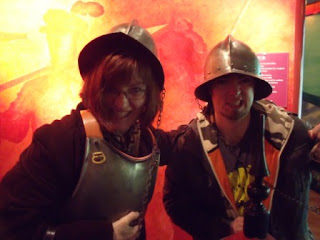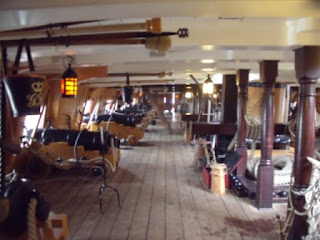We took a boat ride around the harbour first and as Sid had predicted, the newest ship in Britain’s navy was in port, a Type 45 destroyer, the HMS Daring. It was actually located very close to the Victory, which is dry docked. The Daring is still being outfitted but it will be one of the most advanced ships in the world, capable of tracking enemy ships up to 3000 kilometers away and can also track an object the size of a cricket ball moving at Mach 3! It’s a very futuristic looking ship and I couldn’t help but think what Nelson would think of it. There were a couple of aircraft carriers, the HMS Ark Royal and HMS Illustrious and also another half a dozen destroyers and supply ships. Sid and I were up on the upper outside deck for most of the tour and when it began to rain, the captain welcomed us into the bridge. He was not only piloting the ship but narrating the tour over a microphone and made some humorous quips.
An observation tower in the harbour:

After the tour, we entered the Mary Rose museum. The Mary Rose was the prized ship of King Henry the 8th in the 1500s. Her sister ship, really a brother I guess, had the funny name of Peter Pomegranate! The Mary Rose was in service for 33 years but was lost near the shore during a battle where it is likely that it capsized after taking on water through its bottom cannon portholes when turning too quickly, although that is just a hypothesis. Supposedly the king was there and witnessed the sinking himself...would have loved to see his reaction (from a distance).
Scary warriors:

Next up was venturing onto the HMS Victory. What an impressive sight this ship must have been in full battle with its sails flying and 100 guns blazing. This was my third visit to the Victory but it still amazes me the conditions that the men and young boys must have endured both in battle and at peace. The guns range from small 12 pounders on the deck that can be aimed to massive 42 pound guns (the weight being that of the cannonball). Each cannon would be manned by eight to twelve sailors and a young boy, known as a powder monkey, who would run up and down the ship collecting gun powder for the cannon during battle. The sound, heat, small and utter chaos must have been overwhelming. At the back of the ship was the admiral’s dining room and living quarters, quite impressive compared to what the average sailor had. Up on the poop deck (a raised deck near the back of the ship) was the main living area for the captain, Thomas Hardy, who was 6’4 and must have knocked his head many a time on the cramped lower decks. The rigging on the masts was amazing and I wondered how you could remember what sheet did what. The main mast rises 205 feet above sea level, what a view one would have had from up there. Of course, first you had to climb up there with no safety gear whatsoever!
HMS Victory:


On one of the cannon decks:

During the Battle of Trafalgar, Admiral Nelson strayed from the conventional strategy of the time and instead of using a long, single file line of his ships, he broke his fleet into two columns. The old school of thought was that it was easier for all ships to see the signal flags of the flagship (hence the name) if they were all in a row. The enemy would do the same and they would simply sail in two parallel lines while blasting the hell out of each other and then see who was left floating at the end of it all. Instead, Nelson’s two columns were to approach the Franco-Spanish fleet perpendicularly with one column cutting the enemy 1/3 of the way along the enemy’s fleet and the other at the 2/3 point so that the middle section would be cut off. The problem with this was that the English would have to endure the full brunt of the broadside cannonade of the French until they intersected them. In the end, the strategy paid off. In the heat of the battle however, Nelson foolishly went up on deck in his full regalia as the Victory was interlocked with the French ship Redoutable and he was pegged off by a French sniper’s musket fire. He died four hours later but after he had learned that the English had won the battle.
A few of us then set foot on the HMS Warrior, a sail and steam ship launched in 1861. It never actually fired a shot in battle but acted as a deterrent against the French and other enemies of England. The decks were much more spacious than the Victory and only those of 6 feet and taller have to duck once in a while. The ship is nearly twice as long as the Victory and its armour consisting of teak and iron and could withstand a hit from any armament of the day (and supposedly even take an Exocet missile hit without breaching). The men who worked in the boiler rooms were paid 50% more than other sailors and they deserved it. It must have been hell on water shovelling coal into the 20+ boilers with temperatures around 48 C. The massive propeller of the ship could be raised up to reduce drag when not in use but it would take the muscle power of 400 men to do so! All in all, the Warrior was a very impressive ship but it was sadly only in use for 12 years!
HMS Warrior:


Another great day out and thanks again to Gemma for her awesome mini-bus driving!

No comments:
Post a Comment